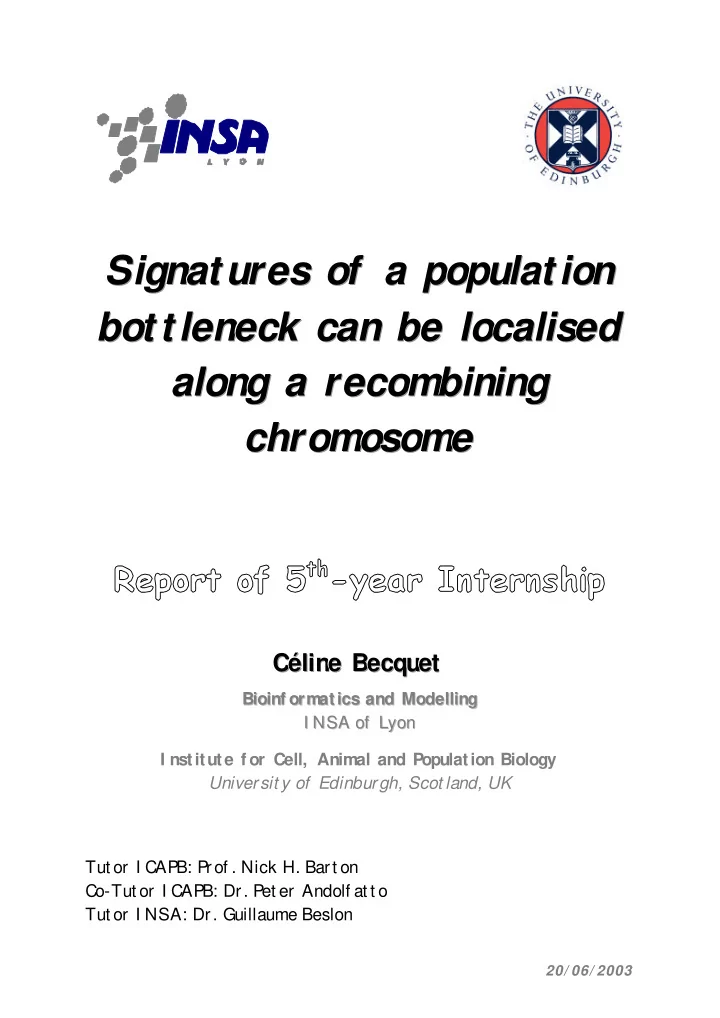

S Si i ig g gn n na a at t t u u ur r re e es s s o o of f f a a a p p po o op pu p u ul l la a at t t i i io on o n n S b o t t l e n e c k c a n b e l o c a l i s e d bo ot t t t l le en ne ec ck k c ca an n b be e l lo oc ca al li is se ed d b a l o n g a r e c o m b i n i n g a al lo on ng g a a r re ec co om mb bi in ni in ng g c ch h hr r ro o om m mo o os s so o om m me e e c C é l i n e B e c q u e t Cé C él li in ne e B Be ec cq qu ue et t Bi io oi in nf f o or rm ma at t i ic cs s a an nd d M Mo od de el ll li in ng g B I N I NS SA A o of f L Ly yo on n I nstitute f or Cell, Animal and Population Biology Universit y of Edinburgh, Scot land, UK Tut or I CAP B: P rof . Nick H. Bart on Co-Tut or I CAP B: Dr. P et er Andolf at t o Tut or I NSA: Dr. Guillaume Beslon 20/ 06/ 2003
Céline BECQUET ICAPB, Edinburgh, 09/02 – 06/03 Signatures of a population bottleneck can be localised along a recombining chromosome ABSTRACT Most statistical tests proposed to detect selection are sensitive to demographic factors such as changes in population size. Unlike the localised effect of strong selection, demographic factors are expected to have a similar effect on the whole genome. While this is generally true, we show that signatures of a population bottleneck can be more localised. We characterise spatial patterns of variability across a recombining chromosome that has experienced a recent and strong population bottleneck event. Interestingly, a bottleneck in the presence of recombination results in increased heterogeneity in variability patterns along a chromosome, reminiscent of the effects of selection. Since changes in population size may be common events in the history of natural populations, our results have implications for the interpretation of genome-wide scans of variability in Drosophila and humans.
Céline BECQUET ICAPB, Edinburgh, 09/02 – 06/03 Signatures of a population bottleneck can be localised along a recombining chromosome Content ABSTRACT Content A Year- I nternship in I CAPB, Edinburgh, Scotland, UK. . 1 Scientif ic report. . . . . . . . . . . . . . . . . . . . . . . . . . . . . . . . . . . . . . . . . . . . . . 3 1. INTRODUCTION..................................................................................3 1.1. DISTINGUISHING DEMOGRAPHY AND SELECTION.......................................... 3 1.2. STATISTICAL TESTS PROPOSED............................................................................. 4 1.3. DATA FOR DROSOPHILA AND HUMANS.............................................................. 4 1.4. INTEREST OF DETECTING SIGNATURE OF A BOTTLENECK........................... 5 2. MATERIALS AND METHODS ............................................................6 2.1. BOTTLENECK SIMULATIONS.................................................................................. 6 2.1.1. Drosophila populations.......................................................................................... 7 2.1.2. Human populations ................................................................................................ 7 2.2. STATISTICAL TESTS.................................................................................................. 8 2.2.1. Levels of variability................................................................................................ 8 2.2.2. Frequency spectrum............................................................................................... 8 a) T AJIMA ’s (1989_a) D............................................................................................... 8 b) F AY and W U ’s (2000) H.......................................................................................... 9 2.2.3. Linkage disequilibrium........................................................................................... 9 High frequency haplotypes (H UDSON et al. 1994, V IEIRA and C HARLESWORTH 2000)... 9 a) b) Number of haplotypes (S TROBECK 1987)................................................................ 9 3. RESULTS.............................................................................................10 3.1. DROSOPHILA POPULATION PARAMETERS....................................................... 10 3.2. HUMAN POPULATION PARAMETERS. ................................................................ 11 3.3. LARGE SURVEY REGIONS IN DROSOPHILA...................................................... 13 3.3.1. Pattern of variability............................................................................................ 13 3.3.2. Increase of the linkage disequilibrium................................................................. 14 3.4. LARGE SURVEY REGIONS IN HUMANS.............................................................. 15 3.4.1. Pattern of variability............................................................................................ 15 3.4.2. Increase of the linkage disequilibrium................................................................. 15 4. DISCUSSION.......................................................................................16 4.1. INTERPRETATION OF SIGNIFICANT TESTS OF FREQUENCY SPECTRUM.. 16 4.1.1. T AJIMA ’s D............................................................................................................ 16 4.1.2. F AY and W U ’s H test ............................................................................................. 17 4.2. INTERPRETATION OF SIGNIFICANT TESTS TEST OF THE LEVEL OF POLYMORPHISM .............................................................................................................. 17
Céline BECQUET ICAPB, Edinburgh, 09/02 – 06/03 Signatures of a population bottleneck can be localised along a recombining chromosome 4.3. HAPLOTYPE TESTS AND LINKAGE DISEQUILIBRIUM.................................... 17 5. CONCLUSION AND PROSPECTS.....................................................18 Epilogue. . . . . . . . . . . . . . . . . . . . . . . . . . . . . . . . . . . . . . . . . . . . . . . . . . . . . . . 19 ACKNOWLEDGMENT LITERATURE CITED SUPPLEMENTS TABLE 2. SUPPLEMENT A...............................................................................................I TABLE 2. SUPPLEMENT B..............................................................................................II FIGURE 1. PATTERN OF VARIABILITY ALONG LARGE REGIONS IN DROSOPHILA AND HUMANS FOR S .......................................................III FIGURE 1. CONTINUED. PATTERN OF VARIABILITY FOR K ............................... IV FIGURE 1. CONTINUED. PATTERN OF VARIABILITY FOR f MFH . ...........................V FIGURE 1. CONTINUED. PATTERN OF VARIABILITY FOR D ............................... VI FIGURE 1. CONTINUED. PATTERN OF VARIABILITY FOR H ..............................VII
Recommend
More recommend